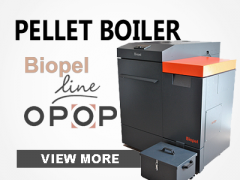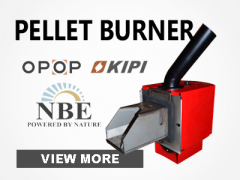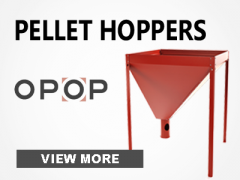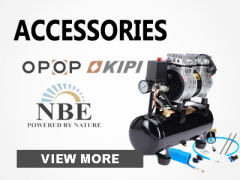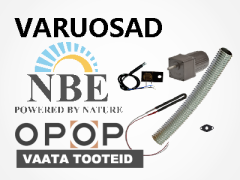Pellet boiler
Pellet boilers are used as central heating systems for single family homes (up to 30 kW) but also for larger residential or business units with heat requirements of a few hundred kW. Similar to wood chip fuel heating systems pellet fuel is delivered periodically and automatically from the pellet storage (for central heating systems) or the day tank (for pellet stove) according to need in the combustion chamber. The heat distribution is the same as in other systems, which use water for heat distribution. Pellet boilers are equiped with controllers that can control boilers circulation pump and temperature of returning water to the boiler, in addition, depending on controller, they can be capeable of adjusting mixing units with circulation pump, extra circulation pumps for solar heat or circulation pumps for water heating systems. Thease systems dont need accumulation tank but can be fitted.
The furnace is automatically supplied with combustible material. The control technology of the system regulates the fuel input gradually in order to match the required heat output. Depending on the specific system, the supplied wood pellets are automatically ignited either with hot air blowers, or it uses a permanent ember bed in the combustion chamber. Wood pellet heating systems work with different techniques of charging and combustion. Most systems available today have a power control over the fuel and combustion air supply, so that they can be operated at full load or at part load. Currently pellet boilers achieve a combustion efficiency of about 85-95% at full load (nominal thermal output) in thermal power operation. With very high efficiency, chimney systems have to be suitable for wet and acid conditions as temperatures in chimney can be 80 C. Recomended to use insulated modular stainless steel chimney or ceramic modular chimney systems.
To convey the pellets from the storage facility to the boiler room, different systems can be used(blower or screw systems). The choice depends primarily on the distance from the storage to the boiler room. For distances greater than two-three meters flexible multi-stage screw conveyors are usually necessary. Blower systems can be used flexibly and feed distances up to 20 m. The discharge from the storage room or container is usually also supported by an inclined tank bottom or a hopper outlet.
Pellet
- The energy content of wood pellets is approximately 4.7 – 5.2 MWh/tonne.
- BTU equivalent: 1 ton pellets = ~450 liter of heating oil.
- Emissions such as NOx, SOx and volatile organic compounds from pellet burning equipment are in general very low in comparison to other forms of combustion heating.
- Wood pellets are environmentally friendly. They are a sustainable fuel source and the amount of the carbon dioxide emitted during the burning process is equivalent to the amount absorbed during the growth of the trees.
- Wood pellets are a renewable energy source. They are produced from forest-thinning byproducts. According to research and wood pellet boiler reviews, wood pellet heating will remain indefinitely as a renewable energy source.
- Even when using high-quality pellets made of solid wood (where the ash content constitutes no less than 0,5%), you’ll end up with around 5 kilogrammes of ash after burning 1 ton of wood pellets.
Wood pellets are the most common type of pellet fuel and are generally made from compacted sawdust[3] and related industrial wastes from the milling of lumber, manufacture of wood products and furniture, and construction. Pellets are categorized by their heating value, moisture, ash content and dimensions. They can be used as fuels for power generation, commercial or residential heating, and cooking. Pellets are extremely dense and can be produced with a low moisture content (less than 10%) that allows them to be burned with a very high combustion efficiency. Further, their regular geometry and small size allow automatic feeding with very fine calibration. They can be fed to a burner by auger feeding or by pneumatic conveying. Their high density also permits compact storage and transport over long distance. They can be conveniently transported a storage area on a customer's premises.
Pellets are produced by compressing the wood material which has made to a uniform dough-like mass. This mass is fed to a press, where it is squeezed through a die having holes of the size required (normally 6 mm diameter, sometimes 8 mm or larger). The high pressure of the press causes the temperature of the wood to increase greatly, and the lignin plasticizes slightly, forming a natural "glue" that holds the pellet together as it cools. Pellets can be made from other non-woody forms of biomass that do not contain lignin.
Pellets conforming to the norms commonly used in Europe (DIN 51731 or Ö-Norm M-7135) have less than 10% water content, are uniform in density (higher than 1 ton per cubic meter, sinks in water)(bulk density about 0.6-0.7 ton per cubic meter), have good structural strength, and low dust and ash content.
Pellets conforming to the European standards norms which contain recycled wood or outside contaminants are considered Class B pellets. Recycled materials such as particle board, treated or painted wood, melamine resin-coated panels and the like are particularly unsuitable for use in pellet burners, since they may produce noxious emissions and uncontrolled variations in the burning characteristics of the pellets.
There are three general types of pellet heating appliances, free standing pellet stoves, pellet stove inserts and pellet boilers.
- Pellet stoves - a mechanical auger automatically feeds the pellets from hopper into a burn pot, where they are incinerated at such a high temperature that they create no vent-clogging creosote and very little ash or emissions. Inside, the pellet stove is controller, thermostat and fans—all of which work together to heat your space efficiently.
- A pellet stove insert is a stove that is inserted into an existing masonry or prefabricated wood fireplace. Fireplace insert Pellet boilers can be standalone heating or central hot water systems designed to replace traditional fossil fuel systems in residential, commercial and institutional applications.
- Automatic or auto-pellet boilers include hoppers (silos for bulk storage of pellets and a fuel delivery system that moves the fuel from the silo to the hopper), a logic controller to regulate temperature across multiple heating zones and can have automated ash removal, boiler- and burner cleaning systems for long-term automated operations.



